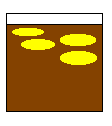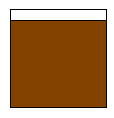 An example of suspension
oil mixed with water.
An example of suspension
oil mixed with water.Topic 9: Solutions
a) What is a solution?
Solutions are homogeneous mixtures. Every day, people use solutions such as mouth wash, diet soda, window cleaner, and gasoline. Most of the chemicals perplex use at home or on the job are solutions. Most of the chemicals you use in your chemistry lab are in solution because reactions often occur faster in solution.
Suspension: A mixture that appears uniform while being stirred, but separates into different phases when agitation ceases.
 An example of suspension
oil mixed with water.
An example of suspension
oil mixed with water.
Solvent: the material dissolving the solute to make the solution.
 An example of a solvent
looks like one solution.
An example of a solvent
looks like one solution.
b) What does concentration mean?
Concentration: Ratio of solute to solvent or solution.
Units of measure is a concentration. A common concentration measure in chemistry is molarity, which is the moles of solute per liter of solution. The important feature of all concentration measures is the ratio expressed. There are many ratios that express how much of some substance is present.
c) Why do some things dissolve while others don't?
The easiest way to determine whether something will dissolve is to add it to a solvent and watch what happens. Polar solvents dissolve ionic and polar solutes by attracting them into the solvent. Non polar substances will not dissolve in water. The polarity of a molecular substance can be predicted by determining the polarity of the individual bonds and the effective poles of the particles.
Can insoluble substances mix? An emulsion is a mixture of tow insoluble substances. Ordinarily, emulsions will form two phrases on standing. Emulsifying agents stabilize emulsions by dissolving partly in a polar droplet and partly in a nonpolar droplet. This linking prevents the droplets from recombining to form two phases.
d) How are solubility principles used? (Dry cleaning, vitamins and solubility, gas solubility)
The principles can be used. Dry cleaning uses nonpolar solvents to dissolve solutes such as oily dirt and greasy stains without harming delicate fabrics. Gases are more soluble at increased pressures and lower temperatures. Vitamins can be water soluble (polar) or fat soluble (nonpolar). Water-soluble vitamins are regulated by the kidneys. Fat-soluble vitamins link with special proteins to travel in the blood. Fat-soluble vitamins are stored in the liver.